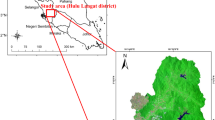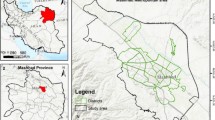Abstract
This paper is about spatial–temporal variability of atmospheric temperature across Taiwan, an island with diverse local emission sources partly because of its Asian cultural characteristics. To develop a new land use regression (LUR) model for this study, we used the temperature data collected by the Taiwan Central Weather Bureau from 2000 and 2016, while using the data from 2017 as the external data verification to assess model reliability. Because incense and joss money burning is a cultural-specific emission source in Asia, we further included location of temples, cemeteries, and crematoriums as potential predictors. The overall model performance and tenfold cross-validated are R2 of 0.88 and R2 of 0.87, respectively, which presents a high level of prediction performance. Moreover, we used our LUR model to estimate urban heat islands intensity (UHII) for six metropolises in Taiwan and found Taichung City has the highest UHII value (4.60 °C) among them. These results provide important insights in expanding the remote sensing application on spatial–temporal variation of atmospheric temperature and its further application on UHI effects.




Similar content being viewed by others
References
Ahmed A, Ossen D, Jamei E, Manaf N, Said I, Ahmad M (2015) Urban surfacetemperature behaviour and heat island effect in a tropical planned city. Theor Appl Climatol 119:493–514
Arnfield AJ (2003) Two decades of urban climate research: a review of turbulence, exchanges of energy and water, and the urban heat island. Int J Climatol 23(1):1–26
Basu R (2009) High ambient temperature and mortality: a review of epidemiologic studies from 2001 to 2008. Environ Health 8:40. https://doi.org/10.1186/1476-069X-8-40
Basu R, Samet JM (2002) Relation between elevated ambient temperature and mortality: a review of the epidemiologic evidence. Epidemiol Rev 24(2):190–202
Chen XL, Zhao HM, Li PX, Yin ZY (2006) Remote sensing image-based analysis of the relationship between urban heat island and land use/cover changes. Remote Sens Environ 104(2):133–146
Corburn J (2009) Cities, climate change and urban heat island mitigation: localising global environmental science. Urban Stud 46(2):413–427
Demers MN (2005) Fundamentals of geographic information systems. John Wiley&Sons, Inc., New York
Directorate General of Budget (DGB ) (2020) National Statistics-Current Index. Available https://eng.stat.gov.tw/mp.asp?mp=5
Field CB, Barros V, Stocker TF, Dahe Q (2012) Managing the risks of extreme events and disasters to advance climate change adaptation: special report of the intergovernmental panel on climate change. Cambridge University Press https://www.ipcc.ch/site/assets/uploads/2018/03/SREX_Full_Report-1.pdf
Guo YM, Gasparrini A, Armstrong B, Tawatsupa B, Tobias A, Lavigne E, Coelho MDZS et al (2016) Temperature variability and mortality: a multi-country study. Environ Health Persp 124(10):1554–1559
Hsu CY, Wu CD, Hsiao YP, Chen YC, Chen MJ, Lung SCC (2018) Developing land-use regression models to estimate PM2.5-bound compound concentrations. Remote Sensing 10(12)
Hsu CY, Wu JY, Chen YC, Chen NT, Chen MJ, Pan WC, Lung SCC, Guo YL, Wu CD (2019) Asian culturally specific predictors in a large-scale land use regression model to predict spatial-temporal variability of ozone concentration. Int J Env Res Pub He 16(7)
IPCC (2014) Climate Change 2014 Synthesis Report Summary for Policymakers. https://www.ipcc.ch/site/assets/uploads/2018/02/AR5_SYR_FINAL_SPM.pdf
Kuo SC, Tsai YI, Sopajaree K (2015) Emission identification and health risk potential of allergy-causing fragrant substances in PM2.5 from incense burning. Build Environ 87:23–33
Liu L, Zhang YZ (2011) Urban heat island analysis using the Landsat TM data and ASTER data: a case study in Hong Kong. Remote Sens 3(7):1535–1552
Lui KH, Bandowe BA, Ho SS, Chuang HC, Cao JJ, Chuang KJ, Lee SC, Hu D, Ho KF (2016) Characterization of chemical components and bioreactivity of fine particulate matter (PM2.5) during incense burning. Environ Pollut 213:524–532
Pan WC, Wu CD, Chen MJ, Huang YT, Chen CJ, Su HJ, Yang HI (2016) Fine particle pollution, alanine transaminase, and liver cancer: a Taiwanese prospective cohort study (REVEAL–HBV). J Natl Cancer Inst 108
Raisanen J, Raty O (2013) Projections of daily mean temperature variability in the future: cross-validation tests with ENSEMBLES regional climate simulations. Clim Dynam 41(5–6):1553–1568
Singh P, Kikon N, Verma P (2017) Impact of land use change and urbanization on urban heat island in Lucknow city, Central India. A remote sensing based estimate. Sustain Cities Soc 32:100–114
Smoyer-Tomic KE, Kuhn R, Hudson A (2003) Heat wave hazards: an overview of heat wave impacts in Canada. Nat Hazards 28(2–3):463–485
Stocker TF (2014) Climate change 2013: the physical science basis: working group I contribution to the fifth assessment report of the intergovernmental panel on climate change. Cambridge University Press, New York https://www.ipcc.ch/site/assets/uploads/2017/09/WG1AR5_Frontmatter_FINAL.pdf
Tomlinson CJ, Chapman L, Thornes JE, Baker C (2011) Remote sensing land surface temperature for meteorology and climatology: a review. Meteorol Appl 18(3):296–306
Wu CD, Lung SCC, Jan JF (2013) Development of a 3-D urbanization index using digital terrain models for surface urban heat island effects. Isprs J Photogramm 81:1–11
Wu CD, McNeely E, Cedeno-Laurent JG, Pan WC, Adamkiewicz G, Dominici F, Lung SCC, Su HJ, Spengler JD (2014) Linking student performance in Massachusetts elementary schools with the “greenness” of school surroundings using remote sensing. PLoS One 9(10)
Wu CD, Chen YC, Pan WC, Zeng YT, Chen MJ, Guo YL, Lung SC (2017) Land-use regression with long-term satellite-based greenness index and culture-specific sources to model PM2.5 spatial–temporal variability. Environ Pollut 224:148–157
Ye XF, Wolff R, Yu WW, Vaneckova P, Pan XC, Tong SL (2012) Ambient temperature and morbidity: a review of epidemiological evidence. Environ Health Persp 120(1):19–28
Yu KP, Yang KR, Chen YC, Gong JY, Chen YP, Shih HC, Lung SCC (2015) Indoor air pollution from gas cooking in five Taiwanese families. Build Environ 93:258–266
Yuan F, Bauer ME (2007) Comparison of impervious surface area and normalized difference vegetation index as indicators of surface urban heat island effects in Landsat imagery. Remote Sensing of Environ 106(3):375–386
Zanobetti A, O'Neill MS, Gronlund CJ, Schwartz JD (2012) Summer temperature variability and long-term survival among elderly people with chronic disease. P Natl Acad Sci USA 109(17):6608–6613
Acknowledgments
We appreciate the data support from the Research Center for Environmental Changes, Academia Sinica, and National Health Research Institutes. We also thank the anonymous reviewers for their constructive comments on the early manuscript of this paper.
Funding
This research was funded by Ministry of Science and Technology, Taiwan, (MOST 107-2621-M-001-003-; MOST 107-2119-M-006-030) and Academia Sinica, Taiwan (AS-SS-107-03).
Author information
Authors and Affiliations
Corresponding author
Ethics declarations
Disclaimer
The contents are solely the responsibility of the authors and do not necessarily represent the official views of the funding agencies. The funders had no role in the design of the study; in the collection, analyses, or interpretation of data; in the writing of the manuscript, or in the decision to publish the results.
Conflict of interest
The authors declare that they have no conflict of interest.
Additional information
Publisher’s note
Springer Nature remains neutral with regard to jurisdictional claims in published maps and institutional affiliations.
Electronic supplementary material
ESM 1
(DOCX 506 kb)
Rights and permissions
About this article
Cite this article
Hsu, CY., Ng, UC., Chen, CY. et al. New land use regression model to estimate atmospheric temperature and heat island intensity in Taiwan. Theor Appl Climatol 141, 1451–1459 (2020). https://doi.org/10.1007/s00704-020-03286-1
Received:
Accepted:
Published:
Issue Date:
DOI: https://doi.org/10.1007/s00704-020-03286-1




